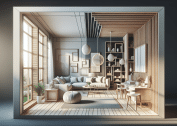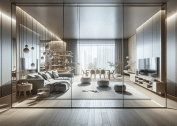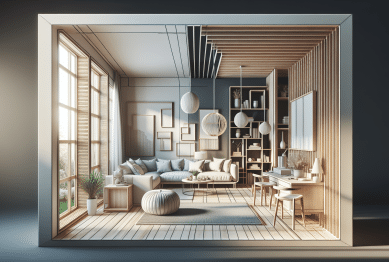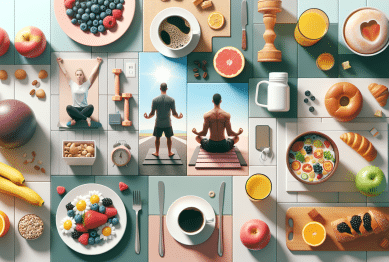Discover the allure of minimalist decor trends and how these aesthetic choices impact your lifestyle and living space. This guide explores practical ideas, design principles, and the psychological benefits that draw so many people to simplicity and calm.
Understanding the Minimalist Decor Aesthetic
The minimalist decor trend has surged in popularity due to its emphasis on simplicity, intentionality, and clean design. Embracing minimalist decor, many households are actively reducing clutter and focusing on only what is essential. Streamlined furnishings, neutral color palettes, and open spaces characterize this look, which has become a leading lifestyle trend for individuals wanting less chaos in their environment. By choosing minimalist interior design, many discover a sense of peace and improved concentration that is hard to achieve with more crowded decor choices.
This aesthetic is more than just an absence of excess. It fosters clarity and mindfulness daily, influencing not only the physical space but also mental well-being. Homeowners who integrate minimalist decor often report enhanced productivity and reduced anxiety. For those exploring home improvement, this trend provides a structure for making thoughtful, lasting selections in furniture and home accessories, aligning every element with a desired lifestyle outcome.
Minimalist spaces are crafted through deliberate design—each item selected serves a purpose or brings joy. This trend isn’t about deprivation but about making conscious choices. The growing preference for minimalist principles echoes across social platforms and lifestyle resources, showing a shift in how people perceive comfortable living. The focus on quality over quantity, natural light, and functional layouts is why this decor style continues to influence both modern and traditional homes alike.
The Key Benefits of Adopting Minimalist Decor
Why do so many choose minimalist decor? The psychological benefits play a major role. Studies have shown that an organized, clutter-free environment reduces stress and supports mental clarity. By removing visual distractions, minimalist spaces can help individuals concentrate and relax. This is especially appreciated in busy urban environments where tranquility at home becomes essential for well-being.
Financial savings are often an unexpected advantage of minimalist living. Without the urge to acquire unnecessary decor items, people find themselves saving money and investing in higher-quality essentials. Minimalist decor aligns with sustainable living, as it encourages mindful consumption and more eco-friendly choices. Home improvement efforts are redirected toward timeless solutions, resulting in less waste and a more eco-conscious home.
Finally, the minimalist approach can simplify daily routines. With fewer items to manage, cleaning and organizing become easier and less time-consuming. Some enthusiasts share how their commitment to minimalist decor has developed into a broader minimalist lifestyle — extending to wardrobe selection, digital habits, and even social commitments. This holistic improvement makes minimalism much more than an interior design trend; it’s a catalyst for positive life changes.
Minimalist Decor Essentials for Every Room
Transforming a space into a minimalist haven doesn’t require a complete remodel. Start by assessing each room and identifying unnecessary items that disrupt the flow. In the living room, this might mean removing extra side tables, selecting a neutral-toned sofa, and using functional storage solutions. The result is a serene, welcoming environment that invites relaxation and connection.
The minimalist kitchen emphasizes uncluttered countertops, streamlined utensils, and open shelving. Prioritizing essential kitchen gadgets and adopting functional design elements, such as under-cabinet lighting and integrated appliances, contributes to a seamless cooking environment. Bathrooms benefit equally from minimalist principles—think simple tile patterns, floating vanities, and hidden storage for a spa-like feel.
Bedrooms shine when minimalist decor is employed through subdued linens, restrained wall art, and decluttered nightstands. Incorporate soothing textures, soft colors, and quality over quantity in both furnishings and decor. These choices are proven to foster better sleep and a calm start to each day, making this aesthetic not only visually appealing but deeply practical.
Minimalist Color Palettes and Materials
The cornerstone of minimalist design is a muted color palette, anchored by whites, grays, beiges, and earth tones. These understated hues help make spaces feel bigger and brighter. Some proponents recommend introducing limited accent colors – perhaps a touch of deep green from plants or a piece of artwork – to add personality without clutter.
Material choices also shape the minimalist vibe. Natural materials such as wood, linen, and stone elevate simplicity while providing comforting texture. Glass and metal elements are often utilized in hardware and fixtures, contributing visual lightness and contemporary appeal. The interplay between these materials creates engaging but soothing interiors.
Minimalism isn’t about sterility or coldness, but about careful curation. Textiles like wool throws, cotton curtains, and jute rugs warm up spaces, while still aligning with the minimalist ethos of simplicity and function. For those seeking inspiration, lifestyle blogs and interior design sites are filled with examples of innovative material combinations that respect minimalist principles.
Decorating Sustainably with Minimalist Principles
One of the core strengths of the minimalist decor trend is its alignment with sustainable living. By championing quality over quantity, advocates for minimalism often support ethical, long-lasting products. This reduces the frequency of replacement and the amount of waste generated by constant decor shifts. The aesthetic, therefore, is described not only as beautiful but as socially responsible.
Sourcing local, handmade, or recycled products for your minimalist home brings a unique story and sense of purpose to each item. Many designers suggest considering the lifecycle of each decor piece, opting for furnishings that can be refurbished or recycled rather than thrown away. Even when faced with a desire to refresh the decor, upcycling existing items or swapping pieces with friends can achieve a new look without more consumption.
Education about eco-friendly decor options continues to expand online. People researching minimalist lifestyles are likely to encounter resources that provide data-driven guides to selecting environmentally responsible furnishings. With growing interest in green design and mindful consumption, these elements have become a seamless part of the minimalist home improvement journey, benefiting both individuals and the environment.
Practical Steps to Achieve Minimalist Decor at Home
Embarking on a minimalist decor transformation is best taken step by step. Begin by evaluating personal needs and removing items that no longer serve a purpose. Storage is key—hidden drawers, modular furniture, and open shelving can maintain order while allowing spaces to breathe. Consistency in style across rooms lends a cohesive feeling to the home, supporting the minimalist lifestyle trend.
Intentional placement maximizes both utility and style. Try arranging furniture to optimize natural light and walkways, which enhances a sense of spaciousness. Incorporate one or two statement pieces, such as a distinctive lamp or a large-scale photograph, to anchor the room without overwhelming it. Changing habits, like keeping horizontal surfaces clear and sticking to a regular decluttering schedule, supports the minimalist environment long-term.
The journey toward minimalist decor can inspire a deeper connection with one’s home. Many enthusiasts report feelings of accomplishment and pride as their spaces become more manageable and enjoyable. Numerous design platforms offer practical checklists, visual guides, and support communities to help those keen on adopting the minimalist lifestyle. Explore more options to refine your own minimalist journey.
References
1. U.S. Department of Energy. (n.d.). Reducing Clutter at Home: Benefits and Techniques. Retrieved from https://www.energy.gov/energysaver/reducing-clutter-home
2. Harvard Health Publishing. (n.d.). Decluttering and Organizing for Better Health. Retrieved from https://www.health.harvard.edu/mind-and-mood/declutter-your-home-declutter-your-mind
3. The Spruce. (n.d.). How to Create a Minimalist Home. Retrieved from https://www.thespruce.com/how-to-create-a-minimalist-home-4105831
4. National Association of Home Builders. (n.d.). Sustainable Home Building Practices. Retrieved from https://www.nahb.org/advocacy/industry-issues/sustainability-and-green-building
5. Psychology Today. (n.d.). The Mental Health Benefits of Minimalism. Retrieved from https://www.psychologytoday.com/us/blog/your-emotional-meter/202003/the-mental-health-benefits-minimalism
6. Architectural Digest. (n.d.). Minimalist Home Design Principles. Retrieved from https://www.architecturaldigest.com/story/minimalist-home-design









